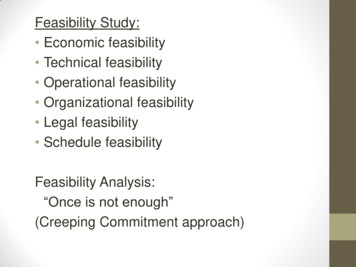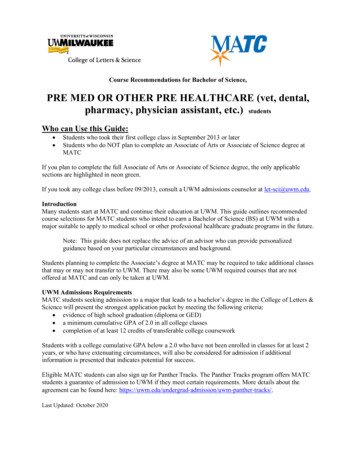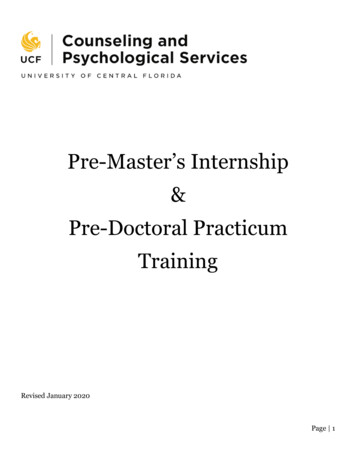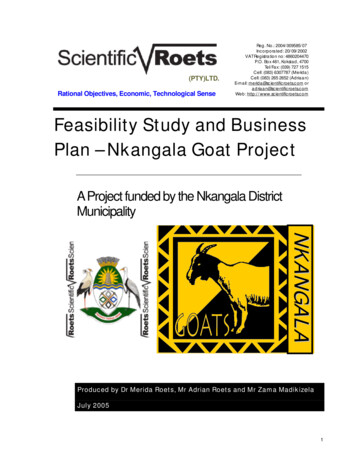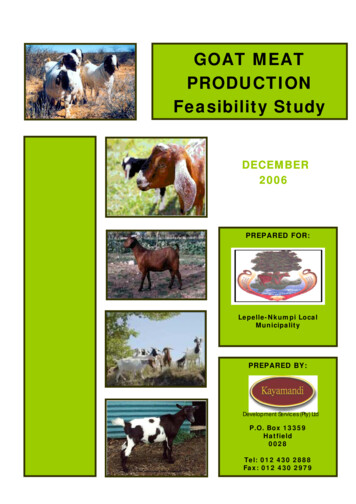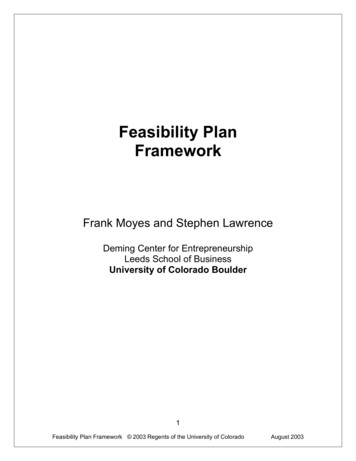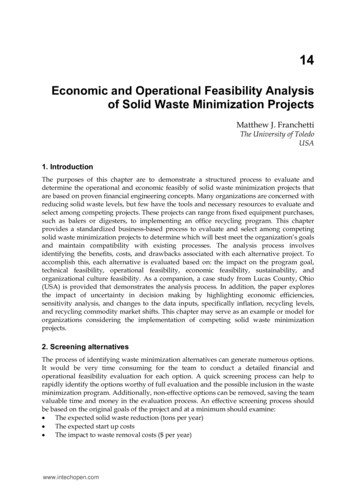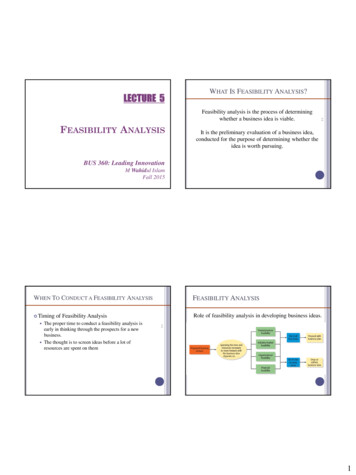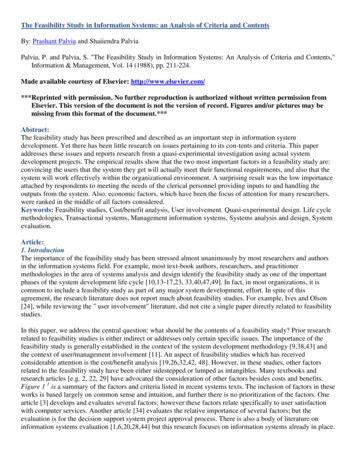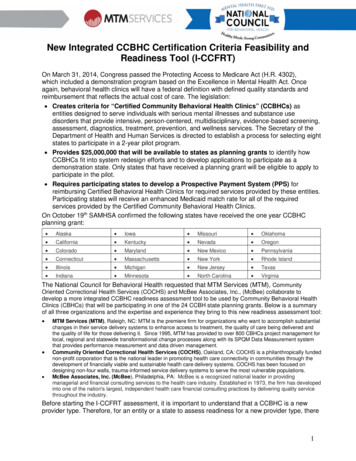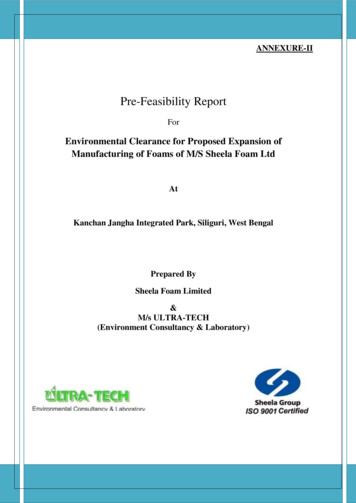
Transcription
ANNEXURE-IIPre-Feasibility ReportForEnvironmental Clearance for Proposed Expansion ofManufacturing of Foams of M/S Sheela Foam LtdAtKanchan Jangha Integrated Park, Siliguri, West BengalPrepared BySheela Foam Limited&M/s ULTRA-TECH(Environment Consultancy & Laboratory)
TABLE OF CONTENTS1. INTRODUCTION AND JUSTIFICATION OF THE PROJECT . 41.1 Identification of Project . 41.2 Identification of Project Proponent . 41.3 Need of Project and its Importance . 51.4 Demand Supply Gap: . 51.5 Import Vs. Indigenous Production . 61.6. Export Potential. 71.7 Employment Generation: . 72. SITE INFORMATION . 82.1 Location . 82.2 Topography . 142.3 Land-use Pattern . 143. PROJECT DESCRIPTION . 153.1 Type of Project . 153.2 Size and Magnitude of Operation . 153.3 Project Description with Process Details: . 173.3.1 Manufacturing Process: . 183.3.2 Process Flow Diagram: . 193.3.3. Material and Water Balance:. 203.4 Utilities . 213.4.1 Water Demand & its Source . 214.1 Water Regime . 224.3Noise Pollution . 234.4Waste Management . 235. PROJECT COST ESTIMATES . 255.1 Project Cost Estimates . 256. ANALYSIS OF PROPOSAL & RECOMMENDATIONS . 26Pre-Feasibility Report for proposed expansion of Sheela Foam Ltd, Jalpaiguri PlantPage 2
LIST OF TABLESTable 1.1: Manpower Details . 7Table 2.1: Geographical Location and Environmental Setting of the project . 8Table 2.2: Plot Break-Up Details . 9Table 3.1: List of Raw Materials for production of PU Foam . 16Table: 3.2 List of Existing Plant Machinery . 17Table 3.3: List of Proposed Machinery. 17Table 3.4: Batch Details . 21Table 4.1: Details of Hazardous Waste generation and Disposal . 24Table 5.1: Break-up Cost of the Project . 25LIST OF FIGURESFig: 2.1 A Connectivity to nearest town (By Road) . 10Fig: 2.1B Connectivity to nearest Airport (By Road) . 10Fig: 2.1C Connectivity to nearest Railway Station (By Road) . 11Figure 2.2: Location Map. 12Figure 2.3: Google Image of Project Site . 13Figure 2.4: Schematic Plant Layout . 14Figure 3.1: Chemical Reaction of Polyurethane formation using TDI & Polyol . 18Figure3.2. Process Flow Diagram . 20Figure 3.3: Water Balance diagram . 21Fig 4.1: STP Diagram . 22Pre-Feasibility Report for proposed expansion of Sheela Foam Ltd, Jalpaiguri PlantPage 3
1. INTRODUCTION AND JUSTIFICATION OF THE PROJECT1.1 Identification of ProjectM/s Sheela Foam Limited is currently producing and processing Poly-Urethane Foam (PUFoam) for various industrial consumers, furniture and bedding applications at Jalpaiguri. Themajor foam today is produced at Greater Noida plant and shipped to Jalpaiguri. As acommitment towards customer, industry and the state, they would like to expand the facility PUFoam production from 300TPM to 600TPM at its Jalpaiguri Unit licated at Kanchan JanghaIntegrated Park, P.O - Jhanjupara, P.S - Rajgung, Jalpaiguri, WB- 735134For the proposed expansion of the PU Foam production, the Project Proponent is willing toexpand the storage of Tolune di isocyanate (TDI) which is one of the raw materials forproduction of PU Foam, from less than 10T to 60T. As per the MSHIC Rules 1989, the thresholdQuantity of storage of TDI is 10MT. So as because the proposed storage quantity is exceedingthe threshold limit, the proposed expansion requires the Environmental ClearanceThe notification no. S. O. 1533 promulgated on 14th September 2006 had covered this industryas Synthetic Organic Chemicals which requires Environmental Clearance (EC) as category ‘A’project under clause 5 (f) as it is not situated within Notified Industrial Estate .1.2 Identification of Project ProponentSheela Foam Limited is the largest foam and mattress company of India. It has manufacturingfacilities all over India. The Main promoter is Mr. Rahul Gautam, who is also the ManagingDirector of the Company. The Company is run by professionals under the guidance of the MDand Board of Directors.The Company is famous for its SLEEPWELL brand of mattresses which is a household name inIndia. The foam of the company is sold under the famous brand of feather foam. The Companyhas foaming plants all over India . These are located in Greater Noida, Talwada, Hyderabad andErode Further it has mattress making plants at 6 more locations spread all over India.The winning brands of Sheela Group includeSLEEPWELL - The flagship brand for mattresses and comfort accessoriesFEATHER FOAM - Pure PU FoamLAMIFLEX - Superior quality polyether/polyester foam for laminationThese are ranked as the largest selling PU Foam in the country.Pre-Feasibility Report for proposed expansion of Sheela Foam Ltd, Jalpaiguri PlantPage 4
1.3 Need of Project and its ImportanceAdvancement in science and technology has created so many products that have enhanced thequality of human life in every passing year. The human race is largely dependent onindustrialization for up gradation in quality of life. Progress of the nation is judged through itseconomic growth which is largely dependent on industrial productivity. PU Foam is used in alarge number of strongly diversified applications, such as filler for seats, chairs and seatcushions, mattress centres, car seats, encapsulation of car windows, shoes and textiles, thermalinsulation (buildings, industrial installations, refrigerators, etc.), sound insulation, adhesives andpaints/coatings, etc. The great advantage of PU foam is its great flexibility in meeting thevarious applications and requirements. Polyurethane owns some extremely exceptional materialqualities such as: density, elasticity, durability, weight, safety, design and of course its attractiveprice.Since PUF is mainly used together with other materials, such as textiles, metal, wood and otherpolymers, it is not always visible in the end products. Polyurethanes are used throughout cars. Inaddition to the foam that makes car seats comfortable, bumpers, interior “headline” ceilingsections, the car body, spoilers, doors and windows all use polyurethanes. Polyurethane alsoenables manufacturers to provide drivers and passengers significantly more automobile“mileage” by reducing weight and increasing fuel economy, comfort, corrosion resistance,insulation and sound absorption.Being a leader in Polyurethane (PU) Foam, Sheela Group is a multi-billion rupee entity. It has anationwide presence in manufacturing PU Foam with a global marketing perspective and animpeccable track record, since 1971. The Company has foaming plants all over India. These arelocated in Greater Noida, Talwada, Hyderabad and Erode Further it has mattress making plantsat 6 more locations spread all over India.With growing complexities in the business and more demanding customers there is a need toexplore setting up more plants at promising locations. For north/east zone, it is decided by theCompany to locate the same at Jalpaiguri. Jalpaiguri is strategically located in chicken neckportion of India, connecting Northeast seven sisters with rest of the country.As a commitment towards customer, industry and the state, they would like to expand thefacility to include PU foam production from 300 MT/Month to 600 MT/Month along with curingand storage.1.4 Demand Supply Gap:Polyurethane foam (PU foam) is a very versatile material. Its open and elastic cell structuresmake it very resistant to oxidation and aging, especially if compared to rubber or latex foams.According to the additives and the manufacturing systems used, very different characteristicsand foams for very different uses can be achieved.Thanks to its diversity, it‟s present in all aspects of daily life. In order to compare the differentfoams we usually use the density, but it only serves as a comparative element when we‟rePre-Feasibility Report for proposed expansion of Sheela Foam Ltd, Jalpaiguri PlantPage 5
talking about foams with the same composition. Their uses are multiple- the insulation capacity,the ease of profiling or shaping, the lightness, the rigidity, etc. The sectors that most use this rawmaterial are: Rest area: in mattresses as main filling or as part of quilts.Furniture sector: in seats of sofas and chairs, padded fillers, etc.Construction sector: as thermal insulation, acoustic absorbent, etc.Automotive sector: in dashboards, seats, etc.In many toys, sponges, shoes, pillows, clothing, packaging and in general all kind offillings and quilting.Growth of polyurethane foam market can be attributed to increasing demand for polyurethanefoam from bedding & furniture and building & construction end-use industries. Significantinvestments in new infrastructure development, new housing projects, and renovation of nonresidential buildings in US, China, India, and Brazil have also influenced the growth of thepolyurethane foam market.India will consume 1 kg of polyurethane (PU) per capita by 2020 at 1200,000 TPA, as per aconservative estimate by the Chairman of the Indian Polyurethane Association (IPUA). Currentper capita PU consumption in India is about 200 grams. The 1 kg per capita target will bepossible, depending mainly on easing bureaucracy by the government that will speed up some ofthe processes and make it easy to set up factories and help to build infrastructure, as well asinitiatives by the industry. At annual consumption levels of 180,000 tons of Polyurethane (PU)in 2007, India has just about 1.5% share of the global PU consumption of 11.25 million tons. Inthe last few years PU has grown at over 15% pa, and is expected to continue to be robust at anaverage rate of 15%. Regionally, polyurethane foam demand is relatively close to productionbecause trade is not economic over larger distances. The production of flexible foam accountsfor the largest share of the Indian polyurethane industry.1.5 Import Vs. Indigenous ProductionPolyurethane foam is an extensively used polymer and plastic. They are available in two formsi.e. rigid and flexible foam
Polyurethane foam (PU foam) is a very versatile material. Its open and elastic cell structures make it very resistant to oxidation and aging, especially if compared to rubber or latex foams. According to the additives and the manufacturing systems used, very different characteristics and foams for very different uses can be achieved.
